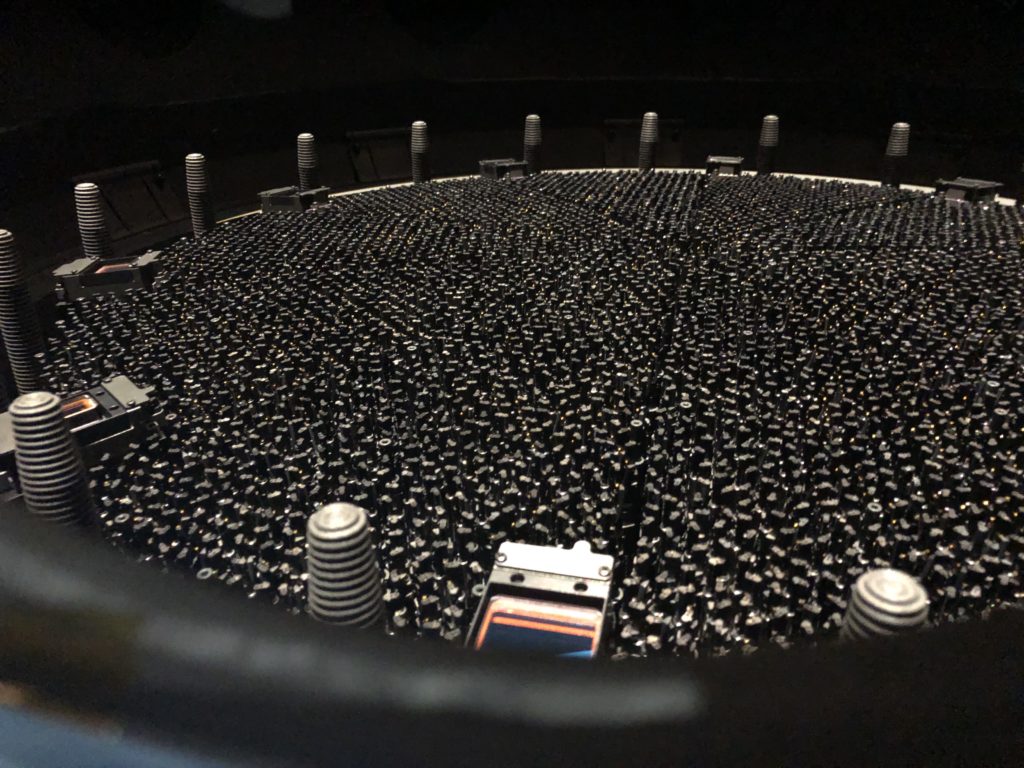On October 22, a new instrument mounted atop a telescope in Arizona aimed 5,000 fiber-optic eyes at the night sky and captured images showing a unique view of the universe.
This milestone marked the first test of the Dark Energy Spectroscopic Instrument, known as DESI, with its nearly complete complement of components.
DESI will formally begin observations in 2020, and, over the next five years, will capture data from 35 million galaxies and 2.4 million quasars-the most luminous objects in the universe-across an area of sky in the Northern Hemisphere. Researchers will use the data collected by DESI to peer back through 12 billion years of the universe's 13.8 billion-year history, unravel more clues to the mystery of dark energy, and ultimately create the most detailed 3-D map of the universe ever made.
Among the DESI participants, who come from 75 institutions in 13 countries, are researchers from the University of Rochester's newly formed cosmology group. A collaboration that includes professors, postdoctoral research associates, graduate students, and undergraduates, the group is unique in that it brings together experts in particle physics, astronomy, data science, and computer science.
"The main goal of DESI is to measure the scale of the universe with far greater precision and speed than ever before," says physics professor Regina Demina, who spearheaded the creation of the cosmology group. "In the era of high-statistics cosmological data, it is important to analyze these data from new and different perspectives. Ideas brought from adjacent areas of research, like particle physics and astrophysics, could be particularly beneficial to progress in the field of cosmology."
Rochester's role: expertise in fiber optics
Under ideal conditions, DESI can cycle through a new set of 5,000 galaxies every 20 minutes. DESI's ability to collect light from 5,000 galaxies simultaneously derives from its unique instrumentation and construction. The top of the DESI telescope is composed of a "focal plane" of 5,000 robotic positioners that swivel in coordination to individually focus on galaxies and quasars. These tiny robots each hold a fiber-optic cable, about the width of a human hair. The fiber optic cables gather light into spectrographs, which are designed to split the gathered light into three separate color bands. Splitting the light allows precise distance measurements of the observed galaxies.

DESI's fully installed focal plane, which features 5,000 automated robotic positioners, each with a fiber-optic cable to gather the light from galaxies. The Rochester group is responsible for ensuring that the 5,000 fibers are optimally pointed at their targets. (DESI collaboration photo)
"This kind of study dates back to the early 1980s, but because DESI is designed with robotically controlled fiber positioners, it can conduct the census 20 times faster than any previous survey," says Segev BenZvi, an assistant professor of physics and a member of the cosmology group.
The Rochester group is responsible for ensuring that the 5,000 fibers are optimally pointed at their targets, by developing and troubleshooting software designed to control the fibers. Demina compares the work to adjusting a television antenna, during the early days of TV, to get a better picture.
"If you are a little bit off center, you will collect less light and will not get a reliable spectrum," she says.
Rochester postdoctoral research associate Satya Gontcho A Gontcho was chosen as one of 10 researchers across the globe to serve as a lead observing scientist on the DESI project. For the next five years, Gontcho will travel to DESI's location at Kitt Peak National Observatory, near Tuscon, Arizona, every other month for week-long rotations. There, she will set up and calibrate the DESI system, make sure it is running properly, and troubleshoot any problems that might arise.
"This is a once-in-a-lifetime chance to really learn with the people who designed and put together DESI and are at the forefront of what we are able to do in cosmology, operations-wise," Gontcho says.
Rochester's robust history of research in optics, physics, and in probing the mysteries of our universe make DESI an ideal project for the cosmology group, BenZvi says.
"At the University of Rochester, we have a long tradition of cutting-edge work in astronomy and fundamental physics. Projects like DESI marry both topics and play to our strengths."

Satya Gontcho A Gontcho in Rome, Italy, accepting the Giuseppe Sciacca International Award for her work in observational cosmology as well as her involvement mentoring future scientists.
Satya Gontcho A Gontcho: 'A historian of the universe'
Satya Gontcho A Gontcho is a postdoctoral research associate in physics at the University of Rochester and a native of France. Her research focuses on a novel field called intergalactic medium-based cosmology. A large portion of the data she uses in her research is gathered from quasars-supermassive black holes that accrete a large amount of matter. The matter heats up and becomes very luminous, spewing jets in opposite directions from the center of the system. Quasars backlight matter in a way similar to a lighthouse illuminating thick clouds on a foggy evening.
DESI will provide Gontcho with even more quasar data, which she will use to analyze the absorption patterns of the intervening matter in the light collected from those quasars. The absorption patterns trace the distribution of matter and could provide a better understanding of how dark energy and dark matter influence the universe.
Because of her contributions to cosmology research, Gontcho was named to Forbes Europe's 30 Under 30 list earlier this year. A self-described "historian/archeologist of the universe," she also recently received the Giuseppe Sciacca International Award for her work in observational cosmology as well as her involvement mentoring future scientists.
"By looking at astronomical objects such as galaxies and quasars, I can gather information about the different periods of the history of the universe," Gontcho says. "On one end, extracting information from my observations and using the information to widen our understanding of the world we live in is incredibly stimulating. On the other end, being able to share this with students who will go out in the world and help shape research going forward is extremely rewarding."






